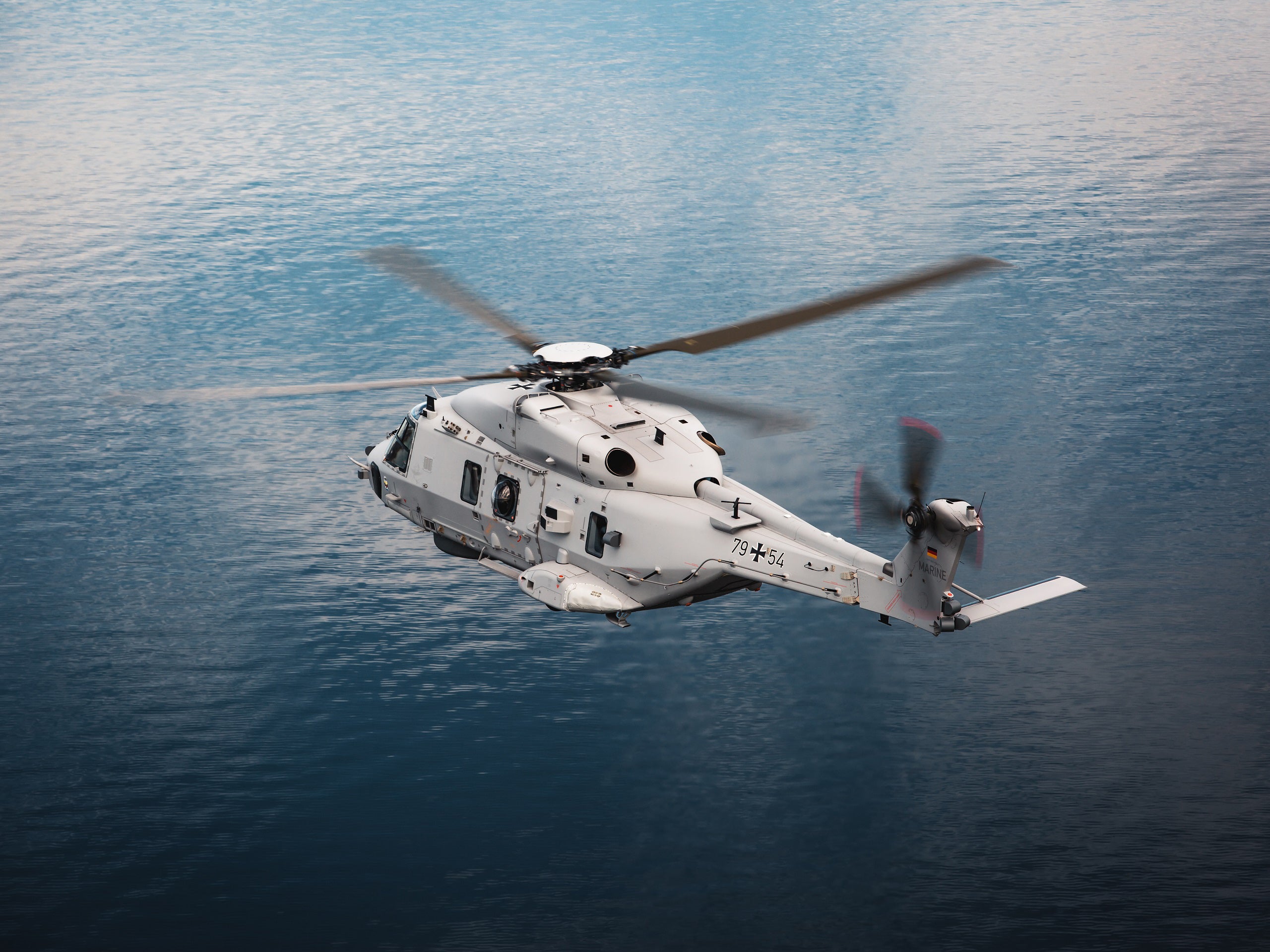
While there is increased attention around the development and testing of uncrewed surface vessels (USVs) used for anti-surface and anti-submarine purposes, anti-submarine warfare (ASW) and anti-surface warfare (ASuW) helicopters still have major strategic importance in keeping fleets safe from enemy submarines and other vessels.
Helicopters are rapidly deployable from vessels and are out of range of torpedoes launched from submarines. They are fitted with sophisticated sensors and armed with torpedoes and missiles that can track and hunt down adversary boats. Such helicopters are often used as multi-role aircraft that perform search and rescue tasks, too.
In recent months, navies around the world announced various programmes related to ASW, ASuW and multi-role helicopters. The growing trend in investing in such capabilities is unsurprising given the progress of submarine projects in development.
Germany’s NH90 helicopters get a sonar upgrade
In February, Germany announced that Thales will equip its NH90 frigate helicopters with its Folding Light Acoustic System for Helicopters (FLASH) sonar that offers advanced ASW capabilities. According to Thales, the dipping sonar system helps detect locate, and classify stealthier submarine types in territorial waters.
The NH90 medium-sized, twin-engine, multi-role helicopter was developed by NHIndustries, the joint venture company of Airbus Helicopters (formerly Eurocopter Group), Leonardo and GKN Fokker, in response to a Nato requirement for a battlefield helicopter that could also be deployed in naval operations. The frigate helicopter can reach speeds of 300km/h with a maximum range of 800km.
FLASH operates on a low-frequency wideband sonar which offers long-range detection and a low false alarm rate in the open ocean and littoral waters. Paired with Thales’s BlueTracker buoy processing solution, the sonar system can provide exceptionally large area coverage.
How well do you really know your competitors?
Access the most comprehensive Company Profiles on the market, powered by GlobalData. Save hours of research. Gain competitive edge.

Thank you!
Your download email will arrive shortly
Not ready to buy yet? Download a free sample
We are confident about the unique quality of our Company Profiles. However, we want you to make the most beneficial decision for your business, so we offer a free sample that you can download by submitting the below form
By GlobalData“In a world where navies are facing growing and sometimes unexpected threats and challenges, ASW is resurging as a key discipline for the 21st century and Thales’ FLASH dipping sonar product range offers the best solutions to ensure navies’ effectiveness and safety at sea,” Thales said in a press statement.
The FLASH system is already ordered or in service today with 18 navies, including the US Navy, the Royal Navy, the French Navy, the Royal Australian Navy, the Royal Norwegian Navy and the Republic of Korea Navy. However, the German NH90 helicopters are set to be the first in the world to receive both the FLASH and the SonoFlash expendable sonar system.
The company also said that the German Navy will receive the most capable variant of the sonar system, but it did not specify beyond that the FLASH will meet Germany’s ASW requirements.

Qatar receives first NH90 naval variants
About a month after the German announcement, the spotlight was on the NH90 again when the Qatar Emiri Air Force received the first two Nato frigate helicopter (NFH) naval variants of the NH90. Leonardo is the prime contractor for the overall programme that sees the delivery of 12 NH90 NFH helicopters from its Venice Tessera facility.
The contract also includes 16 tactical transport helicopter (TTH) version of the NH90 for land operations, which makes Qatar one of the few customers that operate both the NFH and the TTH versions. The programme has the potential to be extended in the future with the addition of six units from each variant.
The company is also supplying simulators, training aids and an extensive maintenance support and training services package for Qatar aircrews and maintenance technicians. It contributes to or supports the integration of various avionics and sensor payloads, including the Leonardo LEOSS-T HD electro-optical system, the HD mission video recorder, automatic identification system, tactical video link and the full HD display for cabin consoles.
In terms of the production of the NH90, Leonardo is responsible for the design, production and integration of the rear fuselage, main gearbox hydraulic system, upper modes of the automatic flight control system, plant management system, power plant integration, NFH mission systems and other mission critical components.
UK set to renew Wildcat support
Since Russia invaded Ukraine, many experts and politicians across Europe have been calling for an urgent review of defence spending, or the lack thereof, especially with respect to land capabilities. It is, however, somewhat understandable why the UK, as an island nation, would choose to prioritise aerial and naval capabilities.
In April, the UK Ministry of Defence’s procurement agency, Defence Equipment and Support, announced it will renew the Wildcat Integrated Support and Training (WIST) agreement with Leonardo UK.
The Wildcat maritime attack helicopter is a key element of the UK’s Carrier Strike Group, providing a multi-role attack capability as it operates from the frigates and destroyers that accompany the Queen Elizabeth-class aircraft carriers. It can carry Sting Ray torpedoes, a door-mounted 0.5” heavy machine gun and new light and heavy variants of the future anti-surface guided weapon missiles.
“Wildcat helicopters play a vital role in supporting our armed forces through reconnaissance, protection and transport. I am delighted they will continue to receive high-quality technical support and training from Leonardo UK,” said UK Minister for Defence Procurement Jeremy Quin in a statement about the renewal.
Elsewhere in Europe, Spain decided to spend $950m on MH-60 multi-mission helicopters with an associated support package. Such investments indicate that helicopters fulfilling anti-surface and anti-submarine operations are here to stay, at least for now.






